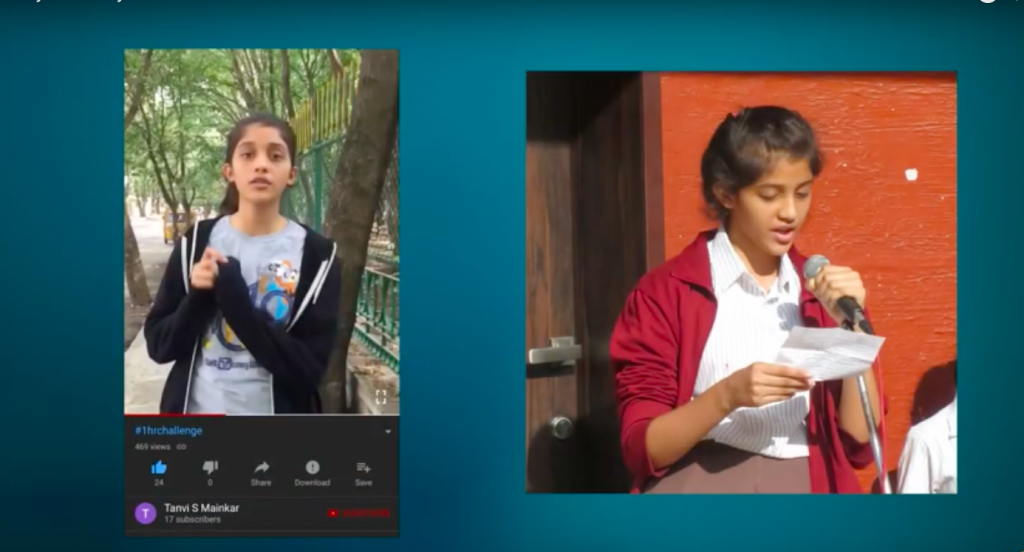Two very strange things happened recently to make me feel that society’s technological over-indulgence was paving the way to disaster. One was a three-year-old girl`s addiction to an electronic device that was so severe as to require digital detox rehabilitation. The other was a girl, just a little older than I am, who got trapped and abused by a predator who started altering photos of her in objectionable ways.
These cases made me start thinking about the darker side of the technological marvels that by and large have changed our life beyond imagination. I also felt that people were overlooking such an obvious negative thing that was standing in front of us, just like a giant gray rhino. I felt that something had to be done to bring more awareness to digital addiction.
So I took on that task as my school project.
My Project: The past decade saw an unprecedented growth in the usage of and dependency on electronic gadgets and social media. While this was happening, it started leaving the traces of a menace bigger than substance abuse affecting people of all ages, gender and ethnic groups. My experience with two instances mentioned above made me think more deeply on this and start my “Digital Detox” project.
I decided to call my project the ‘Gray Rhino’ because this term is used to describe a problem that is wide and big and is staring at you, but you still decide to ignore it. As part of my project, I researched on this by meeting experts like police, doctors and counselors along with parents, kids and adolescents. This eventually not only helped me to understand the problem but also assess the reasons behind it.
I see three main causes of digital addiction:
Release of dopamine. Dopamine is a chemical that is released in our brain whenever we feel happy. Hence passing a level in a game or when the gadget screen lightens up with a notification, Dopamine is released. The more dopamine is released, the more is the urge to use the gadgets.
FOMO/Fear Of Missing Out. Due to this fear, people constantly check their digital devices to keep up with the latest happening in their community, relatives, friends and larger society
Introversion: An introvert would find it easier to use gadgets than socially interact with people due to their innate shyness. Being introverted can make addiction more likely.
Together, these create a vicious cycle which causes various problems such as those related to physical ailments, mental well-being, social skills and legal/criminal issues. Physical problems manifest as pain in wrists, fingers and eye strain. Sleep cycle disturbances, depression and anxiety are some of the problems associated with mental well-being.
I pondered over the solutions that I would propose. While spreading awareness is a big part of the solution, I did not want to preach alone. I wanted to provide alternatives that could help people to cast off their dependence.
I started my work by spreading awareness through video/word blogs, skits in my community/schools and one-on-one discussion. I conducted painting and drawing competitions as an alternative to screen time. I found a startup that manufactures, sells, and popularizes traditional Indian games played with wooden carvings and shells. With their help, I organized these games in my neighborhood. The response went beyond my imagination: more than 150 people engaged for around five hours, during which they completely forgot their gadgets.
I started the “One-hour Challenge” to help people to consciously keep away from their electronic devices for an hour and engage in different activities such as fitness, reading, socializing, artistic forms etc. More than four hundred people have taken up the challenge and vowed to continue with the same.
While I managed to push the wheel up to a point, I also realized that digital detox advocacy required a celebrity push to reach a larger audience. I managed to get the endorsement of my region’s Member of Indian Parliament, Tejasvi Surya, and of a social activist, which resulted in more than 25,000 responses across social media platforms acknowledging the problem and appreciating the solution.
Many have personally reached out to me to replicate this in their respective location, region, or community.
Yes, it is a paradox that I am using social media to advocate digital detox. But I feel this is the best way as I need to reach out to people who are addicted to social media and will not get the message from anywhere else
This effort is just a tip of the iceberg. So much more needs to be done. This requires larger participation and endorsement by governments, NGOs, corporates, experts and the larger public to spread this message far and wide.
So I am traveling to New York City to present my project at the Activate Impact summit at the UN on 4th December.
Staying positive I must say that the journey has just begun….
- The Mobile Phone Addiction Gray Rhino - November 27, 2019


